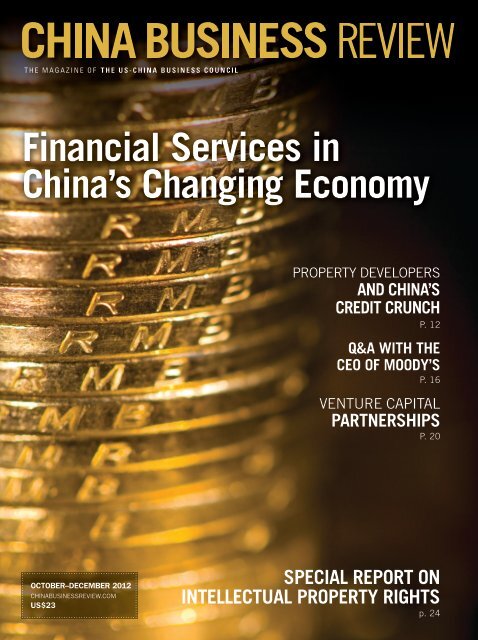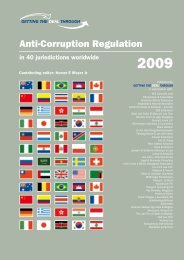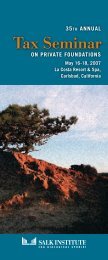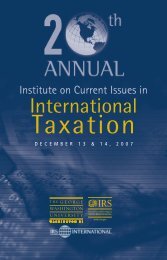China Business Review - 4Q 2012 - Miller & Chevalier
China Business Review - 4Q 2012 - Miller & Chevalier
China Business Review - 4Q 2012 - Miller & Chevalier
You also want an ePaper? Increase the reach of your titles
YUMPU automatically turns print PDFs into web optimized ePapers that Google loves.
Financial Services in<strong>China</strong>’s Changing EconomyProperty Developersand <strong>China</strong>’sCredit CrunchP. 12Q&A with TheCEO of Moody’sP. 16Venture CapitalpartnershipsP. 20October–December <strong>2012</strong>chinabusinessreview.comUS$23Special Report onIntellectual Property Rightsp. 24
export controlsThe Export Control Risks of US-<strong>China</strong>Technology CollaborationBY Jian Bin (Ben) Gao and David HardinAs US-<strong>China</strong> trade expands to higher value goods and services, companies shouldcarefully assess how US export control laws may affect their activities.Imagine chinaUS-<strong>China</strong> trade has grown beyond trade in low-cost goods,and now entails more activities higher up the value chain,such as research and development (R&D), high-tech manufacturing,and Chinese investments in US firms. A consequenceof this trend is the increased exchange of technologybetween the United States and <strong>China</strong>.Such exchanges of technology, while often seemingly anormal part of business collaboration, create a serious riskfor companies subject to stringent US laws applicable to theexport of technology, which include the so called “deemedexport rule.” The risk of technology exchange is that acompany may unknowingly release technology to <strong>China</strong> orChinese nationals in violation of such export control laws,forcing the company to suffer the legal, financial, and reputationaldamage of an enforcement action brought by theUS government.October–December <strong>2012</strong> <strong>China</strong> <strong>Business</strong> <strong>Review</strong> 35
export controlscontrols the manufacturing facility orthe manufactured product will beexported to the United States exclusively.Examples include specification sheetsand technical diagrams required formanufacture. Even the reliance onUS-origin, export-controlled software ortechnology for manufacturing in <strong>China</strong>may result in the end item also becomingsubject to US export control laws. In2011, US company ArvinMeritor Inc.was fined $100,000 by BIS for, amongother things, exporting technical drawingsto <strong>China</strong> without the requiredlicense; the drawings related to exportcontrolledvehicle components and werepresumably intended for manufacturingthe components.Conducting R&D in <strong>China</strong>Like manufacturing, R&D activities in<strong>China</strong> may also require an export licenseif using US-origin, export-controlledsoftware or technology. A commonexample is the use in <strong>China</strong> of R&Dfrom the United States. Reliance on suchsoftware or technology for R&D maylead the outcome of such R&D, whetheran item or further developed technologyor software, itself to become subject toUS export control laws.Collaborating withChinese researchersIf access to US-origin, export-controlledtechnology by Chinese nationalsis not required for manufacturing orR&D, but collaboration involving suchtechnology is nevertheless required, USgovernment authorization may berequired to engage in such collaboration.As a general rule, collaborationimplies sharing of non-public intellectualproperty (IP), which serves as a redflag that authorization is required.Selling to Chinese customersPotential sales to Chinese customersmay require an export license if, duringthe sales process, the customers areexposed to US-origin, export-controlledtechnology that goes beyondgeneral system descriptions. Examplesinclude presentations containing proprietaryinformation not readily availableto the public.Supporting Chinese customersContinued technical support ofChinese customers may require anexport license if such support entailsaccess to US-origin, export-controlledsoftware or technology. Examplesinclude a customer-only Intranet consistingof non-public information,such as user or repair manuals, andsoftware updates.Employing Chinese nationalsEmployment of Chinese nationals,which is becoming more frequent, isthe most common risk scenario forcompanies. Companies are responsiblefor obtaining an export license beforereleasing certain US-origin, exportcontrolledtechnology to any Chinesenational employee, regardless of wherethe release takes place. As an example,BIS just recently imposed a $110,000fine against a Singapore company,Technetics Group Singapore Pte. Ltd.,for transferring export-controlled manufacturinginstructions to two of thecompany’s Chinese national employeesin Singapore without the requiredexport license.Licensing software or technologyto Chinese partnersLicensing of certain US-origin,export-controlled software or technologyto Chinese companies would alsorequire an export license. Red flags thatwould indicate a license requirementinclude arrangements in which thesoftware or technology is proprietary orinvolves access to source code. As anexample, DDTC and the Departmentof Justice (DOJ) recently fined UnitedTechnologies Corp. $75 million for itsrole in helping <strong>China</strong> develop a militaryattack helicopter; among otherthings, the company’s Canadian subsidiarysupplied the Chinese militarywith US-origin, export-controlled softwarethat was modified specifically foruse in that helicopter.Engaging in corporate transactionswith Chinese investorsA corporate transaction that requiresChinese nationals to conduct any duediligence or pre-acquisition reviewentailing US-origin, export-controlledinformation could require an exportlicense. For example, due diligence thatwould require a review of non-public IPsuggests that an export license may beEmployment of Chinese nationals, which is becoming morefrequent, is the most common risk scenario for companies.required. The value of the target in amerger and acquisition scenario may beaffected by export restrictions applicableto its IP assets. Chinese investors shouldknow that US-origin, export-controlledtechnology may not be disclosed toChinese nationals or transferred to<strong>China</strong> without the required license, evenif a Chinese company owns the technologythrough acquisition of the technology’sdesigner or manufacturer.Visiting US companiesVisits to US companies by Chinesenationals may also require an exportlicense if the visit would result in therelease of US-origin, export-controlledtechnology. This is particularly true ifthe visit entails a tour of the assemblyline for an export-controlled item,which could be viewed by the agenciesas a release of technology. The requirementfor a license applies in this scenarioeven if a Chinese company ownsthe US company.Scope of the exportlicense requirementSeveral factors may relieve companiesof an export license obligation. First,generally no export license is required ifthe software or technology to be releasedto the Chinese national is not exportcontrolled, i.e., neither controlled byDDTC nor subject to a BIS licenserequirement. Therefore, correct classificationof software and technology iscrucial for determining the applicablerestrictions. The existence of a minorOctober–December <strong>2012</strong> <strong>China</strong> <strong>Business</strong> <strong>Review</strong> 37
Export controlsdifference in technical characteristicscan dictate whether a particular item isexport controlled.Second, for some export-controlleditems, the corresponding software andtechnology may simply not be exportcontrolled. In those cases, the US governmenthas made the policy decisionnot to subject the software or technologyto the same controls as the item.This determination also requires acareful classification review.Third, technology is not export controlledif does not rise to the level of“development,” “production,” or “use”technology. Definitions for those termsare in the EAR and should be reviewedcarefully against the technology at issuein determining whether the technologyis export controlled.Fourth, publicly available informationis generally not subject to exportcontrols. This exception is subject tomany conditions, highly fact-specific,and subject to different interpretationsdepending on whether the softwareor technology is controlled byDDTC or BIS. Companies shouldreview the regulations and the softwareor technology carefully beforerelying on this exception.Finally, foreign nationals who havebeen awarded US permanent residencyor refugee or asylum status aretreated as US citizens under US exportcontrol laws. Thus, such nationals arenot subject to the deemed export ruleand may access US-origin, export-controlledsoftware and technology withoutan export license.risks are especially acute withrespect to <strong>China</strong><strong>China</strong> is subject to more controlsthan most other countries under theUS export regime. Because <strong>China</strong> issubject to a US arms embargo, theUnited States prohibits the export ofany DDTC-controlled item, technology,or software to <strong>China</strong>. For BIScontrolleditems, technology, and services,<strong>China</strong> is subject to many morecontrols than most countries. Inaddition, a “military end-use” ruleapplies to <strong>China</strong> that prohibits theexport of various classes of items,A widely quoted 2011 report by the Office of the NationalCounterintelligence Executive named <strong>China</strong> as the “most activeand persistent perpetrator of economic espionage” and warnedthat illegal technology transfer to <strong>China</strong> is a threat to US national“prosperity and security.”technology, and software to <strong>China</strong> ifthe export is for a military end-use.Violation of those controls may leadto enforcement actions for whichcivil penalties may reach $500,000per violation and criminal penaltiesmay reach $1 million per violationand imprisonment.Export control enforcement actionshave involved <strong>China</strong> more than mostother countries. Based on civil andcriminal export enforcement data fromBIS, 36 out of 161 actions closed in2010 and 2011 involved <strong>China</strong>, secondonly to Iran at 44. In contrast, onlyseven cases involved Russia and onlythree involved South Korea. Similarly,in a DOJ list of major US exportenforcement, economic espionage,trade secrets, and embargo-relatedcriminal cases, <strong>China</strong> was involved in32 of the 141 “major” cases since2010, tied with Iran.The enforcement focus on <strong>China</strong>,particularly with respect to technologytransfers, will likely continue, if notincrease. A widely quoted 2011 reportby the Office of the NationalCounterintelligence Executive named<strong>China</strong> as the “most active and persistentperpetrator of economic espionage”and warned that illegal technologytransfer to <strong>China</strong> is a threat to USnational “prosperity and security.” Thatreport represents only the latest publicconcern raised by the US governmentabout Chinese theft of US-origin IP.Recent informal statements by DOJand BIS officials confirm that theenforcement agencies have begunaddressing such concerns by steppingupprosecution of such theft throughUS export control laws.Moreover, enforcement of thedeemed export rule is set to intensify. In2011, the Government AccountabilityOffice (GAO) issued the latest in astring of reports criticizing BIS for noteffectively preventing unauthorizedtechnology releases to non-US personsin the United States. The report recommendedthat BIS assess compliancewith the deemed export rule by reviewinga sample of existing H-1B specialtyvisas to “determine whether employersof the applicants should have appliedfor deemed export licenses.” The GAOalso urged BIS to “develop and implementprocedures for incorporatingDepartment of Homeland Securityimmigration data into its enforcementscreening activities.”In February 2011, the US governmentbegan requiring US employers38 <strong>China</strong> <strong>Business</strong> <strong>Review</strong> October–December <strong>2012</strong>
export controlspetitioning to hire foreign workersunder H-1B, L-1, or similar visas tocertify compliance with the deemedexport rule. Specifically, US companiesare required to certify that they haveassessed the technologies that would bereleased to the foreign worker anddetermined whether an export licensewould be required.Unfortunately, the US government’scurrent effort to reform the US exportcontrol system, even if successful, isnot likely to alter the status quo withrespect to <strong>China</strong>. Although one of themany aims of that effort is to relaxexport controls on certain items, software,and technology, it proposes to doso for only select US allies and retainsmany of the <strong>China</strong>-specific policiesand restrictions currently in effect.Existing national security concernswith respect to <strong>China</strong> are all but likelyto preclude any attempt to liberalizeexport controls for that country.Recommended actionsGiven the above regulatory environmentand the US government’s securityconcerns related to <strong>China</strong>, companiescan expect continued, intensifiedenforcement against unauthorizedrelease of US technology to <strong>China</strong>,either through direct or deemedexports. US companies that possesspotentially export-controlled technologyand employ Chinese nationals orcollaborate with Chinese parties nowface greater compliance risks thanever before.The first step in the prudent managementof that risk is to assess whetherand which of the company’s items,technology, and software is export controlledby carefully determining thejurisdiction and classification of each.This can be accomplished by comparingyour company’s items, technology,and software with the classes of items,technology, and software subject to theITAR or identified in the CCL.Depending on the company’s skills,resources, and experience, help fromthird-party export control practitionersmay be warranted.A concurrent assessment, with thehelp of human resources, must identifythe foreign nationals employed by thecompany, the potential access points forexport-controlled items, technologyand software, and the mechanismsrequired to cut off those access pointsabsent required licenses.Finally, where technology or deemedexport risks are real, companies need todraft new or update existing exportcontrol policies that restrict access toexport-controlled technologies andimplement a compliance program commensuratewith their risk level.Jian Bin (Ben) Gao (jgao@milchev.com) is asenior associate at law firm <strong>Miller</strong> & <strong>Chevalier</strong>.His practice focuses on corporate complianceand white collar defense. David Hardin(dhardin@milchev.com) is a counsel at <strong>Miller</strong>& <strong>Chevalier</strong>. His practice focuses on exportcontrol matters for various US agencies.Forecast 2013The Preeminent Conferenceof Its Kind, Now in Its 32nd YearWednesday, January 31, 1:00 – 5:00 pmWashington, DCThe best half day you’ll spend getting a comprehensive projection of the<strong>China</strong> business and political environment in the year ahead. Available tobusiness executives of USCBC member and prospective member companies.Program topics expected to include:»»<strong>China</strong>’s Economy in 2013»»Political Change in <strong>China</strong>: Who is in, Who is out, and Implications forUS-<strong>China</strong> Bilateral Relations»»New US Administration and Congress: <strong>China</strong> Policy and Trade Legislation»»The <strong>Business</strong> Climate in <strong>China</strong>: Top Operating Challenges andOpportunities for US Companies in the Year Ahead»»Keynote from Senior US Government Official or Top Policy AnalystFor more conference details and registration information, see www.uschina.org.USCBC contact: Director of Programs Gloria González-Micklin (Tel: 202-429-0340;programs@uschina.org)October–December <strong>2012</strong> <strong>China</strong> <strong>Business</strong> <strong>Review</strong> 39





